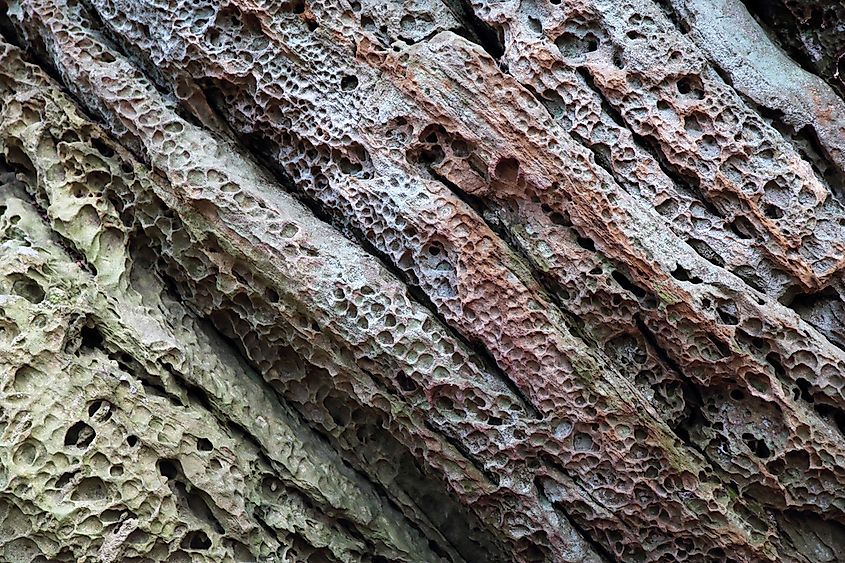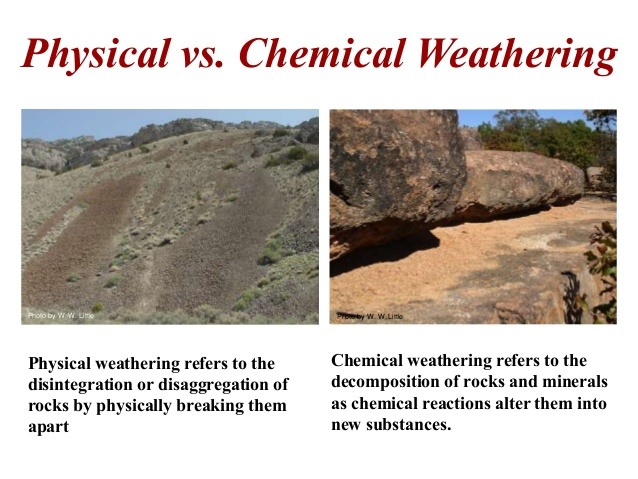9 Which of the Following Describes Chemical Weathering
107185geochemlet1829 Published 27 November 2018. 2018 9 15 doi.

Weathering Erosion Deposition Quizizz
Rocks gradually wear away a process called weathering.

. A study of changes in the Earths surface aligns with the Earth and Space Science and the Science in Personal and Social Perspectives content standards of the National Science Education Standards. ISO 4892-12016 also provides information on the interpretation of data from artificial accelerated weathering or artificial accelerated irradiation exposures. The image shows information about the element carbon as it appears in the periodic table.
Chemical weathering on the other hand is an actual change in composition as minerals are modified from one type to anotherMany if not most of the changes are accompanied by a volumetric increase or decrease which in itself further promotes. Weathering is a process that turns bedrock into smaller particles called sediment. Changes in the Earth and Sky.
Based on the image how many protons does carbon have. -is a chemical property of pure water. Leaching is a naturally occurring process which scientists have adapted for a variety of applications with a variety of methods.
Chapter 4 provides specific guidelines for evaluating the hazards and. Bedrock refers to the solid rock that makes up the Earths outer crust. We are an international team of scientists and entrepreneurs.
Cheremisinoff PhD in Groundwater Remediation and Treatment Technologies 1997 Chemical Weathering. Specific extraction methods depend on the soluble characteristics relative to the sorbent material such as concentration distribution. Unfortunately natural chemical weathering happens too slowly to balance human CO 2 emissions and is already accounted for in Earths present-day carbon budget.
The rock will have some relatively large crystals phenocrysts of the minerals that crystallized early and the rest will be very fine grained or. Leaching is the process of a solute becoming detached or extracted from its carrier substance by way of a solvent. Prudent execution of experiments requires not only sound judgment and an accurate assessment of the risks involved in the laboratory but also the selection of appropriate work practices to reduce risk and protect the health and safety of trained laboratory personnel as well as the public and the environment.
In the most common use of the word this means electrochemical oxidation of. They could increase the amount of chemical weathering. Which of the following terms describes a kind of fold in which the oldest rock layers are in the center of the fold.
They could decrease the amount of chemical weathering. The surface of the earth changes. If that magma is then involved in a volcanic eruption the rest of the liquid will cool quickly to form a porphyritic texture.
Chemical weathering of silicate rocks is a primary drawdown mechanism of atmospheric carbon dioxide. Weathering and erosion are part of the rock cycle. The following excerpt was taken from Chapter 6.
The image shows information about. As a magma cools below 1300C minerals start to crystallize within it. Mechanical weathering includes pressure expansion frost wedging root wedging and salt expansionChemical weathering includes carbonic acid and hydrolysis dissolution and oxidation.
9 217 218 When applied to reduce the CO 2 concentration in the atmosphere mineralization should be treated as a carbon-storage technology because it consists of irreversible chemical reactions aiming to fix CO 2 molecules permanently. More specific information about methods for determining the change in the properties of plastics after exposure and reporting these results is given in ISO 4582. The processes that affect weathering are therefore.
Corrosion is a natural process that converts a refined metal into a more chemically stable oxideIt is the gradual destruction of materials usually a metal by chemical or electrochemical reaction with their environment. K-4 Earth and Space Science. Exercise 34 Porphyritic Minerals.
52 Weathering and Erosion. Biological chemical and physical weathering are three types of weathering. Corrosion engineering is the field dedicated to controlling and preventing corrosion.
The abundance of liquid water on Earths surface and its unique combination of physical and chemical properties are central to the planets dynamics. Waters movementsboth on the land and undergroundcause weathering and erosion which change the lands surface features and create underground formations. Project Vesta is pioneering techniques to accelerate this natural process to remove at least a gigatonne of atmospheric CO 2 per year on a global scale.
Mineralization is thermodynamically favored so it occurs spontaneously in nature being called silicate. Pure water has an acidity of about 7 on the pH scale. By the end of grade 12.
Global climate stabilisation by chemical weathering during the Hirnantian glaciation. Analyze the processes of mechanical and chemical weathering erosion soil structure and type the types of stress leading to rock deformation and the causes of various geological folds and faults. Which of the following is a chemical property pure water.

What Is Chemical Weathering Worldatlas

263 Chemical Weathering Of Rocks Stock Photos Pictures Royalty Free Images Istock

No comments for "9 Which of the Following Describes Chemical Weathering"
Post a Comment